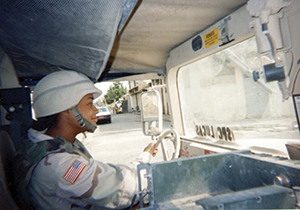
Latoya Lucas was on a resupply mission when she watched a rocket-propelled grenade (RPG) blast the front of her Humvee. The second anti-tank round proved far more catastrophic, as it exploded under her seat, catapulting Lucas out of the vehicle and leaving her exposed to enemy bullets on the road near Mosul, Iraq.
“I passed out due to lack of blood,” she recalls. “And when I came to, I was on the ground bleeding and saw my truck on fire.”
The chaotic attack left her with extensive injuries. “[My leg was] basically not attached to my left foot,” she said. Her pelvis had an open fracture and was broken in half. The eruption of the fire caused third-degree burns up and down her left side and extensive damage to her arm, thigh and abdomen.
The unforgettable moment in July 2003 was supposed to be her day off duty.
The Iraq War officially kicked off four months earlier. The United States invaded, vowing to find and destroy Iraqi weapons of mass destruction and to end the insidious reign of dictator Saddam Hussein.
The regime crumbled in weeks in April when U.S., British and other coalition forces trounced the Iraqi military. By May, President George W. Bush landed on the aircraft carrier USS Abraham Lincoln to declare the end of major combat operations in Iraq. Although he never uttered “mission accomplished” in his speech, the phrase could be seen on a banner hanging in the backdrop.
The mission, however, was anything but complete.
Now, 20 years after the initial invasion, the veterans who fought in Iraq exhibit a broad spectrum of emotions.
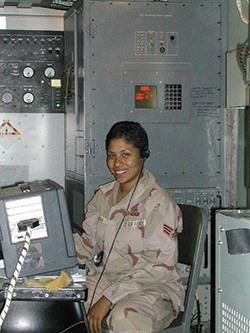

DAV benefits advocate and Air Force veteran Naomi Mathis was excited to deploy to Iraq. As an airman responsible for controlling the fighting airspace, she was involved in mission planning, which motivated her.
“We were pumped,” said Mathis, who is now an associate national legislative director for DAV. “We were going to get these weapons of mass destruction and all of that.”
For much of the American military, including Mathis, the war began in a massive convoy from neighboring Kuwait. Not long after pushing north into Iraqi territory, her mammoth 100-vehicle convoy split in two.
They were about halfway to Baghdad when tragedy struck.
“I remember pulling off to the side of the road, we took our stances, and the convoy was hit,” she said. “We lost someone.”
Her immediate supervisor was injured, and Air Force Staff Sgt. Patrick L. Griffin Jr. was killed. According to the Associated Press, an Air Force investigation later found that he died due to the accidental detonation of unexploded ordnance.
The loss hit Mathis particularly hard. “It changed the entire perspective of why we were there,” she added. “What are we doing?”
By 2004, Iraq warfare had shifted from fighting the uniformed Iraqi army to battling a committed insurgency. Improvised explosive devices (IEDs)—roadside bombs targeting American convoys—became routine, as did urban combat.
Iraq’s most western province, Anbar, was home to some of the war’s fiercest fighting. The Second Battle of Fallujah saw Marines and soldiers enter the densely populated city, estimated to contain 250,000 to 300,000 Iraqi civilians, on Nov. 7, 2004. For six weeks, Americans experienced urban warfare unseen since Vietnam.
The 3-square-kilometer city along the Euphrates River was a grid with more than 2,000 blocks containing 50,000 buildings and structures.
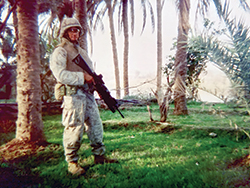

Kyle Morman, a three-time veteran of the Iraq War, found himself deployed just six months after enlisting in the Marines. Reality hit when he and other Marines from 3rd Battalion, 1st Marine Regiment, entered Fallujah in Humvees without extra armor.
“We were making do with what we had available to us,” Morman said.
After crossing the train tracks into the city, Morman immediately saw three dead Iraqis and RPGs, machine guns and AK-47s. The fighting included IEDs rigged like booby traps, with some hanging off buildings. It was mostly small arms fire at first, then the insurgents used heavier weapons, like RPGs.
Four days after the battle began, Morman lost his team leader and good friend, Marine Cpl. Theodore A. Bowling, who was by his side for nearly the entire battle before being killed in a rooftop firefight. Morman had experienced loss in the four months before Fallujah, but losing Bowling on Veterans Day 2004 was different.
“Up until that, up until Fallujah, I hadn’t experienced such a personal loss,” he said. “And I didn’t really think it was going to happen.”
Marine Corps veteran Chris Jarvis also recalls violent and intense urban fighting in Fallujah. His unit struggled for every inch of territory they occupied, and their task was to clear one block each day.
“From the time the sun rose until it got too dark to see, we were shooting,” said Jarvis.
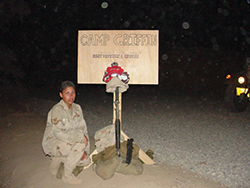

The Second Battle of Fallujah will stand in Marine Corps history next to other infamous battles such as Iwo Jima, Okinawa and Incheon. With 95 Americans killed and hundreds wounded, it was the bloodiest battle of the Iraq War.
The U.S. conceded the war’s pretense of weapons of mass destruction in Iraq in early 2004, and former top United Nations weapon inspector David Kay told Congress at the time, “We were almost all wrong.”
Several challenges thwarted American attempts to quell violence in the years following the invasion, including advanced insurgent networks and an influx of violent foreign extremists. The U.S. was hoping to export democracy and begin building strong institutions that could let Iraqis live prosperous lives.
The U.S. also attempted to train Iraqi security forces and provide safety while trying to root out insurgents. Many Americans, including Army veteran Chris Tschida, were caught in the middle.
On the day he was injured, Tschida was scanning the road when insurgents ran up to his tank and dropped a grenade in the turret.
“When you’re on a tank for eight years, you know what the sounds are when hitting the floor,” said Tschida. “I yelled grenade and put it in the breech. That’s the only place that could withstand that blast.”
The grenade exploded, sending shrapnel back to Tschida and instantly amputating his left hand. Despite his wounds, Tschida, now a DAV benefits advocate in Boise, Idaho, said his combat experience in Iraq helps him provide better service to other veterans.
“A lot of times, veterans are scared that you won’t understand them,” he said. “But when they look at me, and they know I’m a combat vet, they actually open up.”
President Bush agreed to withdraw all American combat troops from Iraq in 2008, and the withdrawal was completed under President Barack Obama in 2011. But while the battle may be over, it never leaves some veterans. Warfighters are violent instruments of policy that, despite being detached from the decision-making, must live with its consequences.
Among those consequences are two pernicious injuries commonly associated with the war—traumatic brain injuries (TBI) and toxic exposures.
As a senior enlisted infantry leader in the Minnesota Army National Guard, Stephen “Butch” Whitehead deployed to Iraq in 2007. As a result of enemy IED attacks, he would become a part of the 10% to 15% of Iraq and Afghanistan veterans, according to Department of Veterans Affairs estimates, who sustained at least one TBI during deployment.
“The military wasn’t prepared for the sheer numbers of TBIs in those early days, and those who served paid a steep price,” said Whitehead, who would go on to serve as the first DAV national commander of the post-9/11 era.
As for toxic exposures, another DAV leader, Dan Clare, chief communications and outreach officer, helped uncover the issue while serving as an airmen in Iraq. He obtained a memo that helped uncover the detrimental effects of open-air burn pits, ultimately leading to a burn pit registry.
“Toxic exposure is a hallmark of suffering for so many in Iraq, but it’s also an affliction that ties us to veterans of other wars, past and present,” Clare said. “The visible and invisible wounds of this war are the latest chapter in a long story.”
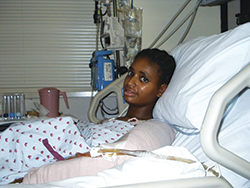

There isn’t a day Lucas doesn’t think of Iraq, particularly when emptying her ostomy bag, which is how she has to excrete her waste. Like many Iraq War veterans, it took years for Mathis to recognize her invisible scars of post-traumatic stress disorder. Morman said he still struggles to find a sense of purpose at times.
“It’s hard to find it when you’ve seen so much death and destruction, and just like where you live on the edge every day,” he added.
And for Jarvis, Iraq and Fallujah are memories of his past, albeit violent and traumatic.
“I feel like it was a chapter in my life,” he said. “But I don’t want it to be my entire story.”






